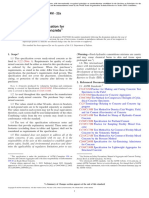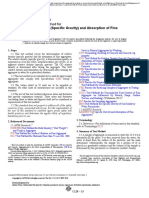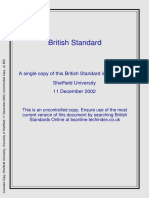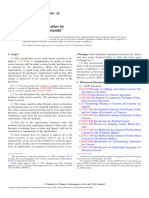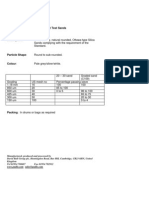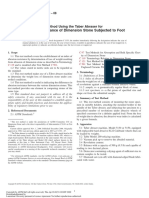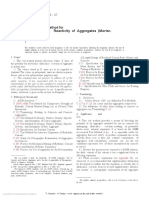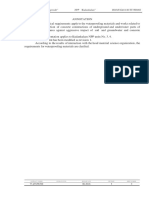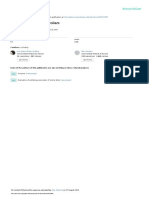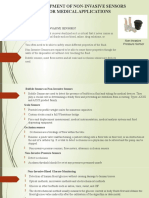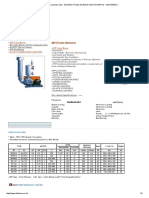Astm C 1260 PDF
Astm C 1260 PDF
Uploaded by
Sourav BasakCopyright:
Available Formats
Astm C 1260 PDF
Astm C 1260 PDF
Uploaded by
Sourav BasakOriginal Title
Copyright
Available Formats
Share this document
Did you find this document useful?
Is this content inappropriate?
Copyright:
Available Formats
Astm C 1260 PDF
Astm C 1260 PDF
Uploaded by
Sourav BasakCopyright:
Available Formats
Designation: C 1260 – 07
Standard Test Method for
Potential Alkali Reactivity of Aggregates (Mortar-Bar
Method)1
This standard is issued under the fixed designation C 1260; the number immediately following the designation indicates the year of
original adoption or, in the case of revision, the year of last revision. A number in parentheses indicates the year of last reapproval. A
superscript epsilon (e) indicates an editorial change since the last revision or reapproval.
1. Scope* of Length Change of Hardened Cement Paste, Mortar, and
1.1 This test method permits detection, within 16 days, of Concrete
the potential for deleterious alkali-silica reaction of aggregate C 511 Specification for Mixing Rooms, Moist Cabinets,
in mortar bars. Moist Rooms, and Water Storage Tanks Used in the
1.2 The values stated in SI units are to be regarded as Testing of Hydraulic Cements and Concretes
standard. The values in inch-pound units are shown in paren- C 670 Practice for Preparing Precision and Bias Statements
theses, and are for informational purposes only. for Test Methods for Construction Materials
1.3 This standard does not purport to address all of the C 856 Practice for Petrographic Examination of Hardened
safety concerns, if any, associated with its use. It is the Concrete
responsibility of the user of this standard to establish appro- D 1193 Specification for Reagent Water
priate safety and health practices and determine the applica- E 11 Specification for Wire Cloth and Sieves for Testing
bility of regulatory limitations prior to use. A specific precau- Purposes
tionary statement is given in the section on Reagents. 3. Terminology
2. Referenced Documents 3.1 Definitions:
2.1 ASTM Standards: 2 3.1.1 relative density (OD), n—as defined in Test Methods
C 109/C 109M Test Method for Compressive Strength of C 127 or C 128, for coarse and fine aggregates, respectively.
Hydraulic Cement Mortars(Using 2-in. or [50-mm] Cube 3.2 For definitions of other terms relating to concrete or
Specimens) aggregates, see Terminology C 125.
C 125 Terminology Relating to Concrete and Concrete
4. Significance and Use
Aggregates
C 127 Test Method for Density, Relative Density (Specific 4.1 This test method provides a means of detecting the
Gravity), and Absorption of Coarse Aggregate potential of an aggregate intended for use in concrete for
C 128 Test Method for Density, Relative Density (Specific undergoing alkali-silica reaction resulting in potentially delete-
Gravity), and Absorption of Fine Aggregate rious internal expansion. It is based on the NBRI Accelerated
C 150 Specification for Portland Cement Test Method (1-4).3 It is especially useful for aggregates that
C 151 Test Method for Autoclave Expansion of Hydraulic react slowly or produce expansion late in the reaction. How-
Cement ever, it does not evaluate combinations of aggregates with
C 295 Guide for Petrographic Examination of Aggregates cementitious materials nor are the test conditions representa-
for Concrete tive of those encountered by concrete in service.
C 305 Practice for Mechanical Mixing of Hydraulic Cement 4.2 Because the specimens are exposed to a NaOH solution,
Pastes and Mortars of Plastic Consistency the alkali content of the cement is not a significant factor in
C 490 Practice for Use of Apparatus for the Determination affecting expansions.
4.3 When excessive expansions (see Appendix X1) are
observed, it is recommended that supplementary information
1
This test method is under the jurisdiction of ASTM Committee C09 on be developed to confirm that the expansion is actually due to
Concrete and Concrete Aggregates and is the direct responsibility of Subcommittee alkali-silica reaction. Sources of such supplementary informa-
C09.26 on Chemical Reactions.
tion include: (1) petrographic examination of the aggregate
Current edition approved June 1, 2007. Published July 2007. Originally approved
in 1989. Last previous edition approved in 2005 as C 1260 – 05a.
2
For referenced ASTM standards, visit the ASTM website, www.astm.org, or
contact ASTM Customer Service at service@astm.org. For Annual Book of ASTM
3
Standards volume information, refer to the standard’s Document Summary page on The boldface numbers in parentheses refer to a list of references at the end of
the ASTM website. the text.
*A Summary of Changes section appears at the end of this standard.
Copyright © ASTM International, 100 Barr Harbor Drive, PO Box C700, West Conshohocken, PA 19428-2959, United States.
--```,`,```,`,,,`,`,,,,,``,```-`-`,,`,,`,`,,`---
Copyright ASTM International 1
Provided by IHS under license with ASTM Licensee=Purdue University/5923082001
No reproduction or networking permitted without license from IHS Not for Resale, 06/23/2008 12:48:51 MDT
C 1260 – 07
(Guide C 295) to determine if known reactive constituents are be 4 6 0.5 volumes of solution to 1 volume of mortar bars. The
present; (2) examination of the specimens after tests (Practice volume of a mortar bar may be taken as 184 mL. Include
C 856) to identify the products of alkali reaction; and (3) where sufficient test solution to ensure complete immersion of the
available, field service records can be used in the assessment of mortar bars.
performance. 6.3.1 Warning—Before using NaOH, review: (1) the safety
4.4 When it has been concluded from the results of tests precautions for using NaOH; (2) first aid for burns; and (3) the
performed using this test method and supplementary informa- emergency response to spills, as described in the manufactur-
tion that a given aggregate should be considered potentially er’s Material Safety Data Sheet or other reliable safety litera-
deleteriously reactive, the use of mitigative measures such as ture. NaOH can cause very severe burns and injury to unpro-
low-alkali portland cement, mineral admixtures, or ground tected skin and eyes. Suitable personal protective equipment
--```,`,```,`,,,`,`,,,,,``,```-`-`,,`,,`,`,,`---
granulated blast-furnace slag should be evaluated (see last should always be used. These should include full-face shields,
sentence of 4.1). rubber aprons, and gloves impervious to NaOH. Gloves should
be checked periodically for pin holes.
5. Apparatus
5.1 The apparatus shall conform to Specification C 490, 7. Conditioning
except as follows: 7.1 Maintain the temperature of the molding room and dry
5.2 Sieves—Square hole, woven-wire cloth sieves, shall materials at not less than 20 °C (68 °F) and not more than 27.5
conform to Specification E 11. °C (81.5 °F). The temperature of the mixing water, and of the
5.3 Mixer, Paddle, and Mixing Bowl—Mixer, paddle, and moist closet or moist room, shall not vary from 23 °C (73.4 °F)
mixing bowl shall conform to the requirements of Practice by more than 1.7 °C (3 °F).
C 305, except that the clearance between the lower end of the 7.2 Maintain the relative humidity of the molding room at
paddle and the bottom of the bowl shall be 5.1 6 0.3 mm (0.20 not less than 50 %. The moist closet or room shall conform to
6 0.01 in.). Specification C 511.
5.4 Tamper and Trowel—The tamper and trowel shall con- 7.3 Maintain the storage oven or water bath in which the
form to Test Method C 109/C 109M. specimens are stored in the containers at a temperature of 80.0
5.5 Containers—The containers shall be of such a nature 6 2.0 °C (176 6 3.6 °F).
that the bars can be totally immersed in either the water or 1N
NaOH solution. The containers shall be made of material that 8. Sampling and Preparation of Test Specimens
can withstand prolonged exposure to 80 °C (176 °F) and must 8.1 Selection of Aggregate—Process materials proposed for
be resistant to a 1N NaOH solution (see Note 1). The use as fine aggregate in concrete as described in the section on
containers must be so constructed that when used for storing Preparation of Aggregate with a minimum of crushing. Process
specimens, the loss or gain of moisture is prevented by materials proposed for use as coarse aggregate in concrete by
tight-fitting covers, by sealing, or both (see Note 2). The bars crushing to produce as nearly as practical a graded product
in the solution must be placed and supported so that the from which a sample can be obtained. Grade the sample as
solution has access to the entire surface of the bar; therefore, it prescribed in Table 1. The sample shall represent the compo-
should be ensured that the specimens do not touch the sides of sition of the coarse aggregate as proposed for use.
the container or each other. The specimens, if stood upright in 8.1.1 When a given quarried material is proposed for use
the solution, shall not be supported by the metal gauge stud. both as coarse and as fine aggregate, test it only by selection of
an appropriate sample crushed to the fine aggregates sizes,
NOTE 1—The NaOH solution will corrode glass or metal containers.
NOTE 2—Some microwave-proof food storage containers made of unless there is reason to expect that the coarser size fractions
polypropylene or high-density polythylene have been found to be accept- have a different composition that the finer sizes and that these
able. differences might significantly affect expansion due to reaction
5.6 Oven, or Water Bath—A convection oven or water bath with the alkalies in cement or from the environment of service.
with temperature control maintaining 80.0 6 2.0 °C (176 6 3.6 In this case test the coarser size fractions in a manner similar
°F). to that employed in testing the fine aggregate sizes.
8.2 Preparation of Aggregate—Grade all aggregates to
6. Reagents which this test method is applied in accordance with the
requirements given in Table 1. Crush aggregates in which
6.1 Sodium Hydroxide (NaOH)—USP or technical grade sufficient quantities of the sizes specified in Table 1 do not exist
may be used, provided the Na+ and OH− concentrations are
shown by chemical analysis to lie between 0.99N and 1.01N.
6.2 Purity of Water—Unless otherwise indicated, references TABLE 1 Grading Requirements
to water shall be understood to mean reagent water conforming Sieve Size
Mass, %
to Type IV of Specification D 1193. Passing Retained on
6.3 Sodium Hydroxide Solution—Each litre of solution shall 4.75 mm (No. 4) 2.36 mm (No. 8) 10
contain 40.0 g of NaOH dissolved in 900 mL of water, and 2.36 mm (No. 8) 1.18 mm (No. 16) 25
shall be diluted with additional distilled or deionized water to 1.18 mm (No. 16) 600 µm (No. 30) 25
600 µm (No. 30) 300 µm (No. 50) 25
obtain 1.0 L of solution. The volume proportion of sodium 300 µm (No. 50) 150 µm (No. 100) 15
hydroxide solution to mortar bars in a storage container shall
Copyright ASTM International 2
Provided by IHS under license with ASTM Licensee=Purdue University/5923082001
No reproduction or networking permitted without license from IHS Not for Resale, 06/23/2008 12:48:51 MDT
C 1260 – 07
until the required material has been produced. In the case of of cement and mass of aggregate shall be 440 g multiplied by
aggregates containing insufficient amounts of one or more of the aggregate proportion determined in 8.4.3. This aggregate
the larger sizes listed in Table 1, and if no larger material is mass shall be made up by recombining the portions retained on
available for crushing, the first size in which sufficient material the various sieves in the grading prescribed in Table 1 (8.2).
is available shall contain the cumulative percentage of material Use a water-cement ratio equal to 0.47 by mass (see Note 5).
down to that size as determined from the grading specified in NOTE 5—Ruggedness tests indicated that mortar bar expansions were
Table 1. When such procedures are required, make a special less variable at a fixed water to cement ratio than when gaged to a constant
note thereof in the test report. After the aggregate has been flow (3).
separated into the various sieve sizes, wash each size with a
8.4.4 Mixing of Mortar—Mix the mortar in accordance with
water spray over the sieve to remove adhering dust and fine
the requirements of Practice C 305.
particles from the aggregate. Dry the portions retained on the
8.4.5 Molding of Test Specimens—Mold test specimens
various sieves and, unless used immediately, store each such
within a total elapsed time of not more than 2 min and 15 s
portion individually in a clean container provided with a
after completion of the original mixing of the mortar batch. Fill
tight-fitting cover.
the molds with two approximately equal layers, each layer
8.3 Selection and Preparation of Cement:
being compacted with the tamper. Work the mortar into the
8.3.1 Reference Cement—Use a portland cement meeting
corners, around the gauge studs, and along the surfaces of the
the requirements of Specification C 150 (Note 3). In addition,
mold with the tamper until a homogeneous specimen is
the autoclave expansion in Test Method C 151 shall be less
obtained. After the top layer has been compacted, cut off the
than 0.20 %.
mortar flush with the top of the mold and smooth the surface
NOTE 3—The alkali content of the cement has been found to have with a few strokes of the trowel.
negligible (3) or minor (6) effects on expansion in this test.
9. Procedure
8.3.2 Preparation of Cement—Pass cement for use in this
test through an 850-µm (No. 20) sieve to remove lumps before 9.1 Initial Storage and Reading—Place each mold in the
use. moist cabinet or room immediately after molds have been
8.4 Preparation of Test Specimens: filled. The specimens shall remain in the molds for 24 6 2 h.
8.4.1 Number of Specimens—Make at least three test speci- Remove the specimens from the molds and, while they are
mens for each cement-aggregate combination. being protected from loss of moisture, properly identify and
8.4.2 Preparation of Molds—Prepare the specimen molds in make an initial comparatory reading. Make and record the
accordance with the requirements of Practice C 490 except, the initial and all subsequent readings to the nearest 0.002 mm.
interior surfaces of the mold shall be covered with a release Place the specimens made with each aggregate sample in a
agent (see Note 4). A release agent will be acceptable if it storage container with sufficient tap water to totally immerse
serves as a parting agent without affecting the time of setting of them. Seal and place the containers in an oven or water bath at
the cement and without leaving any residue that will inhibit the 80.0 6 2.0 °C (176 6 3.6 °F) for a period of 24 h.
penetration of water into the specimen. 9.2 Zero Readings—Remove the containers from the oven
or water bath one at a time. Remove other containers only after
NOTE 4—TFE-fluorocarbon tape complies with the requirements for a
the bars in the first container have been measured and returned
mold release agent.
to the oven or water bath. The time elapsed between removal
8.4.3 Proportioning of Mortar—Proportion the dry materi- and return of the specimens to the oven or water bath shall not
als for the test mortar using 1 part of cement to 2.25 parts of exceed 10.0 min. Remove the bars one at a time from the water
graded aggregate by mass for aggregates with a relative density and dry their surface with a towel paying particular attention to
(OD) at or above 2.45. For aggregates with a relative density the two metal gauge studs. Take the zero reading (see Note 6)
(OD) below 2.45, determine the aggregate proportion as of each bar immediately after drying, and read as soon as the
follows: bar is in position. Complete the process of drying and reading
Aggregate proportion 5 2.25 3 D/2.65 within 15 6 5 s of removing the specimen from the water.
After readings, leave the specimen on a towel until compara-
tory readings have been taken on the remainder of the bars.
where:
Place all specimens made with each aggregate sample in a
--```,`,```,`,,,`,`,,,,,``,```-`-`,,`,,`,`,,`---
D = relative density (OD) of test aggregate.
container with sufficient 1N NaOH, at 80.0 6 2.0 °C (176 6
3.6 °F) for the samples to be totally immersed. Seal the
8.4.3.1 For aggregates with a relative density (OD) equal to
container and return it to the oven or water bath.
or greater than 2.45, the quantities of dry materials to be mixed
at one time in the batch of mortar for making three specimens NOTE 6—The reference bar should be read prior to each set of
shall be 440 g of cement and 990 g of aggregate made up by specimens since the heat from the mortar bars may cause the length of the
recombining the portions retained on the various sieves in the comparator to change.
grading prescribed in Table 1 (8.2). Use a water-cement ratio 9.3 Subsequent Storage and Measurement—Make subse-
equal to 0.47 by mass (see Note 5). quent comparator readings of the specimens periodically, with
8.4.3.2 For aggregates with a relative density (OD) less than at least three intermediate readings, for 14 days after the zero
2.45, the quantities of dry materials to be mixed at one time in reading, at approximately the same time each day. If readings
the batch of mortar for making three specimens shall be 440 g are continued beyond the 14-day period, take at least one
Copyright ASTM International 3
Provided by IHS under license with ASTM Licensee=Purdue University/5923082001
No reproduction or networking permitted without license from IHS Not for Resale, 06/23/2008 12:48:51 MDT
C 1260 – 07
reading per week. The procedure is identical to that described 11.1.7 Amount of mixing water expressed as mass percent
in the section on Zero Readings except that the specimens are of cement,
returned to their own container after measurement. 11.1.8 A graph of the length change data from the time of
the zero reading to the end of the 16 day period.
10. Calculation
12. Precision and Bias
10.1 Calculate the difference between the zero comparatory 12.1 Within-Laboratory Precision—It has been found that
reading of the specimen and the reading at each period to the the average within-laboratory coefficient of variation for ma-
nearest 0.001 % of the effective gauge length and record as the terials with an average expansion greater than 0.1 % at 14 days
expansion of the specimen for that period. Report the average is 2.94 % (5) (Note 7). Therefore, the results of two properly
expansion of the three specimens of a given cement-aggregate conducted tests within the same laboratory on specimens of a
combination to the nearest 0.01 % as the expansion for the sample of aggregate should not differ by more than 8.3 %
combination for a given period. (Note 7) of the mean expansion.
12.2 Multi-Laboratory Precision—It has been found that
11. Report the average multilaboratory coefficient of variation for materi-
11.1 Report the following information: als with an average expansion greater than 0.1 % at 14 days is
11.1.1 Type and source of aggregate, 15.2 % (5) (Note 7). Therefore, the results of two properly
11.1.2 Type and source of portland cement, conducted tests in different laboratories on specimens of a
11.1.3 Autoclave expansion and alkali content of cement as sample of aggregate should not differ by more than 43 % (Note
percent potassium oxide (K2O), sodium oxide (Na2O), and 7) of the mean expansion.
calculated sodium oxide (Na2O) equivalent (Na2Oeq= %Na2O NOTE 7—These numbers represent, respectively, the (1s %) and
+ 0.658 3 %K2O), (d2s %) limits as described in Practice C 670.
11.1.4 Average length change in percent at each reading of 12.3 Bias—Since there is no accepted reference material for
the specimens, determining the bias of this test method, no statement on bias
11.1.5 Any relevant information concerning the preparation is being developed.
of aggregates, including the grading of the aggregate when it
differs from that given in 8.2, 13. Keywords
11.1.6 Any significant features revealed by examination of 13.1 aggregate; alkali-silica reactivity; length change; mor-
--```,`,```,`,,,`,`,,,,,``,```-`-`,,`,,`,`,,`---
the specimens during and after test, tar; sodium hydroxide
APPENDIX
(Nonmandatory Information)
X1. INTERPRETATION OF TEST RESULTS
X1.1 There is good agreement in the published literature innocuous and deleterious in field performance. For these
(1,2,7-10) for the following expansion limits: aggregates, it is particularly important to develop supplemental
X1.1.1 Expansions of less than 0.10 % at 16 days after information as described in 4.3. In such a situation, it may also
casting are indicative of innocuous behavior in most cases (see be useful to take comparator readings until 28 days (8,10).
Note X1.1).
NOTE X1.1—Some granitic gneisses and metabasalts have been found
X1.1.2 Expansions of more than 0.20 % at 16 days after to be deleteriously expansive in field performance even though their
casting are indicative of potentially deleterious expansion (see expansion in this test was less than 0.10 % at 16 days after casting (10).
4.3). With such aggregate, it is recommended that prior field performance be
X1.1.3 Expansions between 0.10 and 0.20 % at 16 days investigated. In the absence of field performance data, mitigative measures
after casting include both aggregates that are known to be should be taken as discussed in 4.4.
Copyright ASTM International 4
Provided by IHS under license with ASTM Licensee=Purdue University/5923082001
No reproduction or networking permitted without license from IHS Not for Resale, 06/23/2008 12:48:51 MDT
C 1260 – 07
REFERENCES
(1) Oberholster, R. E., and Davies, G.,“ An Accelerated Method for (6) Hooton, R. D.,“ Interlaboratory Study of the NBRI Rapid Test Method
Testing the Potential Alkali Reactivity of Siliceous Aggregates.” and CSA Standardization Status,” Report EM-92, Ontario Ministry of
Cement and Concrete Research, Vol 16, 1986, pp. 181–189. Transport, March 1990, pp. 225–240.
(2) Davies, G., and Oberholster, R. E., “Use of the NBRI Accelerated Test (7) Hooton, R. D., and Rogers, C. A., “Evaluation of Rapid Test Methods
to Evaluate the Effectiveness of Mineral Admixtures in Preventing the for Detecting Alkali-Reactive Aggregates,” Proceedings, Eighth Inter-
Alkali-Silica Reaction,” Cement and Concrete Research, Vol 17, 1987, national Conference on Alkali-Aggregate Reaction, Kyoto, 1989, pp.
pp. 97–107. 439–444.
(3) Davies, G., and Oberholster, R. E., “An Interlaboratory Test Pro- (8) Hooton, R. D.,“ New Aggregate Alkali-Reactivity Test Methods,”
gramme on the NBRI Accelerated Test to Determine the Alkali- Report MAT-91-14, Ontario Ministry of Transportation, November
Reactivity of Aggregates,” National Building Research Institute, 1991.
CSIRO, Special Report BOU 92-1987, Pretoria, RSA, 1987, 16 pp. (9) Fournier, B., and Berube, M. A., “Application of the NBRI Accelerated
(4) Oberholster, R. E., “Alkali Reactivity of Siliceous Rock Aggregates: Mortar Bar Test to Siliceous Carbonate Aggregates Produced in the St.
Diagnosis of the Reaction, Testing of Cement and Aggregate and Lawrence Lowlands, Part 2: Proposed Limits, Rates of Expansion, and
Prescription of Preventative Measures,” Alkali in Concrete, Research Microstructure of Reaction Products,” Cement and Concrete Research,
and Practice, Copenhagen, 1983, Danish Concrete Association, pp. Vol 21, 1991, pp. 1069–1082.
419–433. (10) Hooton, R. D., and Rogers, C. A., “Development of the NBRI Rapid
(5) Rogers, C.A., “Multi-laboratory Study of the Accelerated Mortar Bar Mortar Bar Test Leading to its Use in North America,” Proceedings,
Test (ASTM Test Method C 1260) for Alkali-Silica Reaction,” Ninth International Conference on AAR in Concrete, London, 1992,
Cement, Concrete, and Aggregates, Vol 21, 1999, pp. 185–194. pp. 461–467.
SUMMARY OF CHANGES
Committee C09 has identified the location of selected changes to this test method since the last issue,
C 1260 – 05a, that may impact the use of this test method. (Approved June 1, 2007)
(1) Revised 1.1. (2) Revised 8.4.3, 8.4.3.1, and 8.4.3.2.
Committee C09 has identified the location of selected changes to this test method since the last issue,
C 1260 – 05, that may impact the use of this test method. (Approved December 15, 2005)
(1) Revised the Referenced Documents section. (3) Revised 8.4.3 and added new 8.4.3.1 and 8.4.3.2.
(2) Added a Terminology section.
ASTM International takes no position respecting the validity of any patent rights asserted in connection with any item mentioned
in this standard. Users of this standard are expressly advised that determination of the validity of any such patent rights, and the risk
of infringement of such rights, are entirely their own responsibility.
This standard is subject to revision at any time by the responsible technical committee and must be reviewed every five years and
if not revised, either reapproved or withdrawn. Your comments are invited either for revision of this standard or for additional standards
and should be addressed to ASTM International Headquarters. Your comments will receive careful consideration at a meeting of the
responsible technical committee, which you may attend. If you feel that your comments have not received a fair hearing you should
make your views known to the ASTM Committee on Standards, at the address shown below.
This standard is copyrighted by ASTM International, 100 Barr Harbor Drive, PO Box C700, West Conshohocken, PA 19428-2959,
United States. Individual reprints (single or multiple copies) of this standard may be obtained by contacting ASTM at the above
address or at 610-832-9585 (phone), 610-832-9555 (fax), or service@astm.org (e-mail); or through the ASTM website
(www.astm.org).
--```,`,```,`,,,`,`,,,,,``,```-`-`,,`,,`,`,,`---
Copyright ASTM International 5
Provided by IHS under license with ASTM Licensee=Purdue University/5923082001
No reproduction or networking permitted without license from IHS Not for Resale, 06/23/2008 12:48:51 MDT
You might also like
- Astm C94Document15 pagesAstm C94Enrique Pasquel100% (4)
- Astm C94Document16 pagesAstm C94carlos salinas100% (1)
- Astm C173Document9 pagesAstm C173safak kahraman67% (3)
- Establishing and Implementing A Quality Management System For Construction Materials Testing LaboratoriesDocument28 pagesEstablishing and Implementing A Quality Management System For Construction Materials Testing LaboratoriesXarmd100% (1)
- Astm c1157Document5 pagesAstm c1157Jose Serrano de Enamorado100% (1)
- Astm C511-21Document3 pagesAstm C511-21حسن الزهراني100% (1)
- ASTM C1602-22 Standard Specification For Mixing Water Used in The Production of Hydraulic Cement ConcreteDocument5 pagesASTM C1602-22 Standard Specification For Mixing Water Used in The Production of Hydraulic Cement ConcreteOmid DeldarNo ratings yet
- Concrete Made by Volumetric Batching and Continuous Mixing: Standard Specification ForDocument9 pagesConcrete Made by Volumetric Batching and Continuous Mixing: Standard Specification Formickyfelix100% (2)
- Astm C856Document16 pagesAstm C856Jad Louis100% (2)
- Ready-Mixed Concrete: Standard Specification ForDocument15 pagesReady-Mixed Concrete: Standard Specification ForHishmat Ezz AlarabNo ratings yet
- Astm c33Document11 pagesAstm c33Kiko Nobre100% (1)
- Astm C128Document7 pagesAstm C128Maria Bernal100% (1)
- Astm C939-16 (100%)Document3 pagesAstm C939-16 (100%)Vijayakrishna SingamsettiNo ratings yet
- C1314 18Document9 pagesC1314 18NİLAY SABAHOĞLU100% (2)
- Astm C 1064Document3 pagesAstm C 1064Juan Jesus Garcia ReyesNo ratings yet
- D4832 NormaDocument5 pagesD4832 NormaMike LemusNo ratings yet
- 10 Coiled Tubing Operation PDFDocument51 pages10 Coiled Tubing Operation PDFEdgar Ordoñez100% (7)
- Astm C 87Document4 pagesAstm C 87mickyfelixNo ratings yet
- Determination of Length Change of Concrete Due To Alkali-Silica ReactionDocument7 pagesDetermination of Length Change of Concrete Due To Alkali-Silica ReactionJesús Luis Arce GuillermoNo ratings yet
- Determination of Length Change of Concrete Due To Alkali-Silica ReactionDocument6 pagesDetermination of Length Change of Concrete Due To Alkali-Silica ReactionEvert RiveraNo ratings yet
- Astm C807 Time of Setting Mortar by Modified Vicat NeedleDocument3 pagesAstm C807 Time of Setting Mortar by Modified Vicat NeedleFábio FriolNo ratings yet
- Portland Cement: Standard Specification ForDocument9 pagesPortland Cement: Standard Specification ForHishmat Ezz AlarabNo ratings yet
- ASTM C-845 Expansive Hydraulic Cement1Document3 pagesASTM C-845 Expansive Hydraulic Cement1Hsaam HsaamNo ratings yet
- ASTM C31-19 Standard Practice For Making and Curing Concrete Test Specimens in The FieldDocument6 pagesASTM C31-19 Standard Practice For Making and Curing Concrete Test Specimens in The FieldMalaz Abdul Jalil33% (3)
- Astm C31/31MDocument6 pagesAstm C31/31MIrene Grace BatalaoNo ratings yet
- Astm C618 19Document2 pagesAstm C618 19maniharimeenaNo ratings yet
- Acid-Soluble Chloride in Mortar and Concrete: Standard Test Method ForDocument4 pagesAcid-Soluble Chloride in Mortar and Concrete: Standard Test Method ForRodney SalazarNo ratings yet
- Ready-Mixed Concrete: Standard Specification ForDocument10 pagesReady-Mixed Concrete: Standard Specification ForMinor CastroNo ratings yet
- Water-Soluble Chloride in Mortar and Concrete: Standard Test Method ForDocument3 pagesWater-Soluble Chloride in Mortar and Concrete: Standard Test Method ForSofía Córdoba SáenzNo ratings yet
- C 138Document4 pagesC 138Kevin Castillo IbarraNo ratings yet
- C 1012Document6 pagesC 1012Angel Pecina100% (1)
- ASTM C803 - C803M - 18 Standard Test Method For Penetration Resistance of Hardened ConcreteDocument4 pagesASTM C803 - C803M - 18 Standard Test Method For Penetration Resistance of Hardened Concreteming_zhu10No ratings yet
- Astm C586Document5 pagesAstm C586Raja QamarNo ratings yet
- Astm C-31Document5 pagesAstm C-31Shuvro ChakravortyNo ratings yet
- Preparing and Testing Specimens From Shotcrete Test Panels: Standard Practice ForDocument3 pagesPreparing and Testing Specimens From Shotcrete Test Panels: Standard Practice ForJesus Luis Arce Guillermo100% (1)
- Compressive Strength of Cylindrical Concrete Specimens: Standard Test Method ForDocument8 pagesCompressive Strength of Cylindrical Concrete Specimens: Standard Test Method ForShambhavi DubeNo ratings yet
- BS 4550 3.4 PDFDocument17 pagesBS 4550 3.4 PDFMatt IkhramNo ratings yet
- ASTMD448, Sizes of AggregateDocument3 pagesASTMD448, Sizes of AggregateMuhammad Kamran Gulzar100% (1)
- Astm C-94Document3 pagesAstm C-94Sitotaw AlemuNo ratings yet
- Astm C494Document9 pagesAstm C494Артем ТитовNo ratings yet
- Astm c580 Mortar Flexural PDFDocument6 pagesAstm c580 Mortar Flexural PDFMaha MuflehNo ratings yet
- Air Content of Hydraulic Cement Mortar: Standard Test Method ForDocument4 pagesAir Content of Hydraulic Cement Mortar: Standard Test Method ForVishal ShrivastavaNo ratings yet
- CRD - c48 CRD-C48-92 Standard Test Method For Water Permeability of ConcreteDocument4 pagesCRD - c48 CRD-C48-92 Standard Test Method For Water Permeability of ConcreteazharbNo ratings yet
- Astm D6910 D6910M 19Document2 pagesAstm D6910 D6910M 19tomNo ratings yet
- Astm C94 - C94M - 22Document15 pagesAstm C94 - C94M - 22rupeshkumar.tpl100% (1)
- Astm C144-18Document3 pagesAstm C144-18ing.mtorresgNo ratings yet
- Astm C 185Document3 pagesAstm C 185cristian_agpNo ratings yet
- Astm C140 - 12Document16 pagesAstm C140 - 12jjaavenido100% (11)
- Astm C31-21Document7 pagesAstm C31-21Lázaro Henríquez sandovalNo ratings yet
- Astm C1567 - 13 PDFDocument6 pagesAstm C1567 - 13 PDFAnonymous SBjNS7Gw0qNo ratings yet
- Astm C778-06Document1 pageAstm C778-06Joko SupriyantoNo ratings yet
- C1107Document4 pagesC1107Pankaj PaulNo ratings yet
- Compressive Strength of Masonry Prisms: Standard Test Method ForDocument10 pagesCompressive Strength of Masonry Prisms: Standard Test Method ForAngga AriefNo ratings yet
- Astm C-42Document8 pagesAstm C-42thescubatater100% (4)
- D6103Document3 pagesD6103Mohamed FaragNo ratings yet
- Uncompacted Void Content of Fine Aggregate (As Influenced by Particle Shape, Surface Texture, and Grading)Document5 pagesUncompacted Void Content of Fine Aggregate (As Influenced by Particle Shape, Surface Texture, and Grading)Oscar LopezNo ratings yet
- Astm C1353Document3 pagesAstm C1353Jino Legasto100% (1)
- ASTM C94 Mixed ConcreteDocument13 pagesASTM C94 Mixed ConcreteZega ChrisNo ratings yet
- Astm C 1260 PDFDocument9 pagesAstm C 1260 PDFjorgesilva84No ratings yet
- Potential Alkali Reactivity of Aggregates (Mortar-Bar Method)Document5 pagesPotential Alkali Reactivity of Aggregates (Mortar-Bar Method)Jesús Luis Arce Guillermo100% (1)
- ASTM C 1077 - 06aDocument6 pagesASTM C 1077 - 06aarqcarjuanNo ratings yet
- List of MaterialsDocument41 pagesList of MaterialsSourav BasakNo ratings yet
- TT Water ProofingDocument20 pagesTT Water ProofingSourav Basak100% (1)
- Alkali Reactivity of Aggregate C 1260 PDFDocument5 pagesAlkali Reactivity of Aggregate C 1260 PDFAndrew PiNo ratings yet
- Letter HeadDocument1 pageLetter HeadSourav BasakNo ratings yet
- Studies On Relationship Between Compressive and Splitting Tensile Strength of High Performance ConcreteDocument6 pagesStudies On Relationship Between Compressive and Splitting Tensile Strength of High Performance ConcreteSourav BasakNo ratings yet
- TT Water ProofingDocument3 pagesTT Water ProofingSourav BasakNo ratings yet
- Reliance Infra Temporary Dyke DesignDocument66 pagesReliance Infra Temporary Dyke DesignSourav BasakNo ratings yet
- Corporate Induction Training Programme On Reactor Engineering (NE-04)Document34 pagesCorporate Induction Training Programme On Reactor Engineering (NE-04)Sourav BasakNo ratings yet
- Comparative Study of Beam Using IS: 800-1984 & IS: 800-2007: ISO 9001:2008 CertifiedDocument3 pagesComparative Study of Beam Using IS: 800-1984 & IS: 800-2007: ISO 9001:2008 CertifiedSourav BasakNo ratings yet
- Corrosion Aspects of A Nuclear Power Plant: Chemical LabDocument19 pagesCorrosion Aspects of A Nuclear Power Plant: Chemical LabSourav BasakNo ratings yet
- Alert System For DelhiDocument10 pagesAlert System For DelhiSourav BasakNo ratings yet
- Effects of Soil-Structure Interaction On Multi Storey Buildings On Mat FoundationDocument14 pagesEffects of Soil-Structure Interaction On Multi Storey Buildings On Mat FoundationSourav BasakNo ratings yet
- Material Safety Data Sheet Natural Gas, Compressed (CNG)Document3 pagesMaterial Safety Data Sheet Natural Gas, Compressed (CNG)Mochamad FaisolNo ratings yet
- Astm G 125 - 00Document9 pagesAstm G 125 - 00Ivan AlanizNo ratings yet
- Job Safety Analysis CustodialDocument4 pagesJob Safety Analysis Custodialwahyu nugrohoNo ratings yet
- Catalog MV PDFDocument58 pagesCatalog MV PDFJS Engineering100% (1)
- The Formation and Reactions of CarbanionsDocument6 pagesThe Formation and Reactions of Carbanionsamanda salgadoNo ratings yet
- BS EN ISO 00105-E03-1997 ScanDocument12 pagesBS EN ISO 00105-E03-1997 ScansandeepNo ratings yet
- Matter in Our SurroundingsDocument7 pagesMatter in Our Surroundingsvivek_theeasyways100% (1)
- Acid-Base Balance in BroilersDocument10 pagesAcid-Base Balance in Broilersionut2007No ratings yet
- Safety ApproachDocument5 pagesSafety ApproachOnee chanNo ratings yet
- Development of Non-Invasive Sensors For Medical ApplicationsDocument11 pagesDevelopment of Non-Invasive Sensors For Medical ApplicationsSuyash Dadmal100% (1)
- Pharmacognosy: Short Questions Carrying 4 MarksDocument21 pagesPharmacognosy: Short Questions Carrying 4 MarksRajiv DarogaNo ratings yet
- CMT 2Document47 pagesCMT 2Andrea MagtutoNo ratings yet
- Assay of Benzalkonium ChlorideDocument5 pagesAssay of Benzalkonium ChlorideTantri ayu lestari100% (2)
- File 1 - Enginerring Physics Text BookDocument104 pagesFile 1 - Enginerring Physics Text BookHet PatidarNo ratings yet
- Polylactic Acid Technology: by Ray E. Drumright, Patrick R. Gruber, and David E. HentonDocument6 pagesPolylactic Acid Technology: by Ray E. Drumright, Patrick R. Gruber, and David E. HentonFelipeBohorquezNo ratings yet
- Turbo BlowerDocument2 pagesTurbo BlowerMoedji WidyantoNo ratings yet
- Unit 4 - Chemistry - WWW - Rgpvnotes.inDocument35 pagesUnit 4 - Chemistry - WWW - Rgpvnotes.inAyush Kr. SharmaNo ratings yet
- Coal Power PlantDocument17 pagesCoal Power PlanttonirangkirNo ratings yet
- Study Guide For Chem 9 FinalDocument5 pagesStudy Guide For Chem 9 Finalshuoliu1996No ratings yet
- Chemical Engineering Principles 1Document60 pagesChemical Engineering Principles 1Ayman HammadNo ratings yet
- H&S Quiz AnswersDocument4 pagesH&S Quiz AnswersHashir Badar67% (3)
- Formulas and Naming Molecular CompoundsDocument10 pagesFormulas and Naming Molecular CompoundsNicolás SerranoNo ratings yet
- Animal Testing (Black Mamba)Document3 pagesAnimal Testing (Black Mamba)Robespade El PistoleroNo ratings yet
- Penthouse Summer 1996Document2 pagesPenthouse Summer 1996John M. CavoteNo ratings yet
- Chemistry Research Paper ExampleDocument8 pagesChemistry Research Paper Exampleb0pitekezab2100% (1)
- CE262 17 ConcreteDocument73 pagesCE262 17 ConcreteBenjamin AsiriNo ratings yet
- Salt Analysis BANSAL CLASSESDocument24 pagesSalt Analysis BANSAL CLASSESShantanu MahajanNo ratings yet
- Full Specification U. 250G DW ULC-S601-07 Double Wall SheetDocument5 pagesFull Specification U. 250G DW ULC-S601-07 Double Wall SheetRIFASNo ratings yet
- Nu Tech Catalog 2019 For Website PDFDocument60 pagesNu Tech Catalog 2019 For Website PDFkaranNo ratings yet

